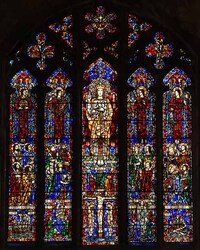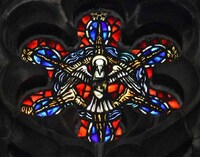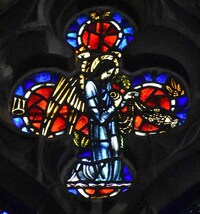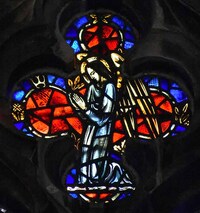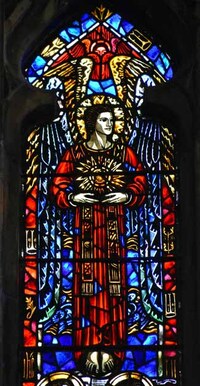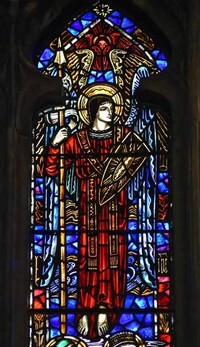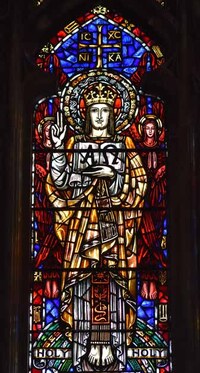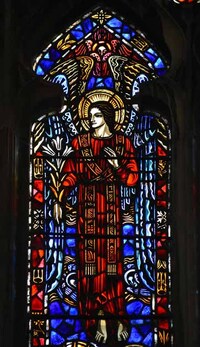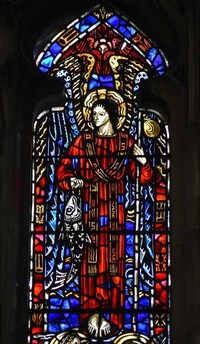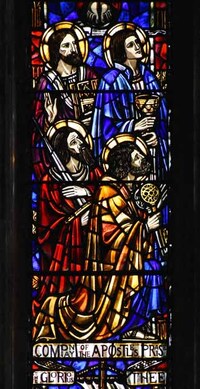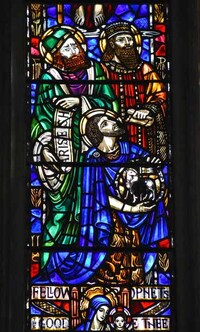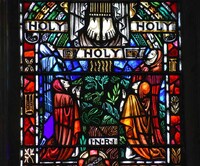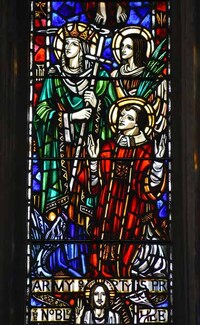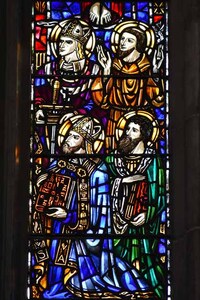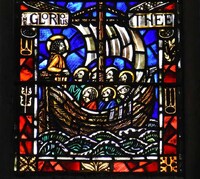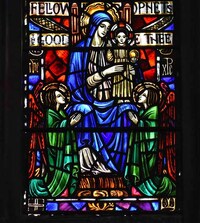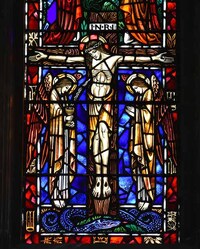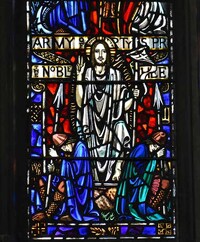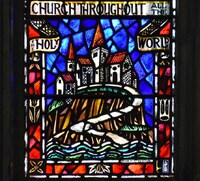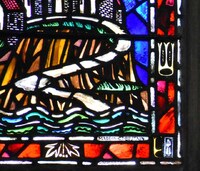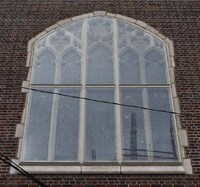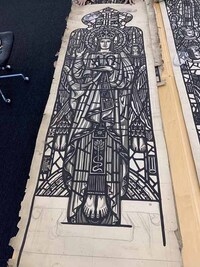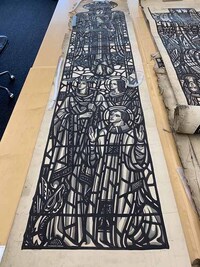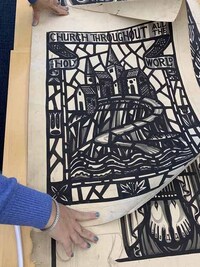Window
Building Name: St. Peter's Episcopal ChurchStudio Name: Powell (James) & Sons (Whitefriars)
City: Detroit
Window Shape: 6 (gothic arched, more than 2 vertical sections)
Date of Window: 1946
Subject/Title of Window: Te Deum Chancel Window
Brief Description of Subject: From the 1987 book "Discovering Stained Glass in Detroit" by Nola Tutag: "The chancel treatment of St. Peter's is English, characterized by a square sanctuary with a [geometrical] traceried window. In 1930 A.A. Buck commissioned a stained glass window for the chancel from James Hogan, a distinguished English glass artist and head of Whitefriars Studios, London. [The contracted price was $4800, about $90,000 in 2022.] The resulting Te Deum Window of five lancets ... is one of the finest glass windows in Detroit and illustrates the ancient hymn of unknown origin "Te Deum Laudamas." Whitefriars closed in 1980 but the records, held by the Victoria and Albert Museum in London, reveal that for the St. Peter's window Hogan chose the most expensive and splendid blue and red glass ... [This window] is composed in medieval fashion: two-dimensional, small mosaic-like pieces of pot-metal and Norman slab glass, and the figures are stylized representations in simple lines and little detail." [The cartoon for this window was gifted by the Victoria and Albert Museum to the Corning Museum of Glass in2008.]
The artist used the "Book of Common Prayer," version of the hymn "Te Deum Laudamas" (We Praise Thee, O God). Sentences in Capital letters are verses from the hymn.
The overall structure of this window is a canopy and three rows split down the center by the middle lancet highlighted by the brightness of Christ's clothes. The canopy and the first row are visually separated from the lower two rows by an overall darker color and a blue "line," thus dividing the window in half. The top half will picture figures in heaven, while the lower half, those on earth --- visually referencing, THE HEAVEN AND EARTH ARE FULL OF THE MAJESTY OF THE GLORY.
Canopy
The top center scene: THINE HONOURABLE HOLY GHOST THE COMFORTER. Pictured is a dove radiating light and surrounded by water. The dove as a symbol of the Holy Spirit comes from John 1:32, at Christ's baptism, "The Spirit came down from heaven as a dove." The water alludes to the Holy Spirit's association with the living water of Baptism.
Side scenes: The angel on the left is praising God with incense while the angel on the right through prayer.
Row 1
Scenes 1,2,4, and 5: TO THEE CHERUBIM AND SERAPHIM: CONTINUALLY DO CRY, HOLY, HOLY, HOLY: LORD GOD OF SABAOTH. (Sabaoth is derived from the Hebrew word for "army." In the context of this phrase from Isaiah 6:3, it refers to the "heavenly army of angels.")
Scene 1:Uriel is pictured holding the sun. This attribute derives from his name which in Hebrew means "Light of God."
Scene 2: Michael is pictured with his attributes of a lance and a shield. This comes from his role as the warrior who leads the Army of God. His most famous battle was against Satan in the Book of Revelation.
Scene 3: THOU ART THE KING OF GLORY: O CHRIST. Christ is depicted in his majesty, flanked by praying angels. He is holding a book with the first and last letters in the Greek alphabet "Alpha" and "Omega" --- this refers to Revelation 1:8 where Christ identified himself as "The Alpha and the Omega, the beginning and the ending." Above his head are the Greek letters IC XC NI KA. The "IC" and "XC" are the first and last letters of the transliterated Greek words for Jesus (IHOCYC) and Christ (XPICTOC); the NI and KA form the Greek word "Nika" which means "conquer;" putting this together "Jesus Christ Conquers." The lines over the "IC" and "XC" indicate a sacred name; the lines over NI KA should not be there. On the strip of cloth above Christ's feet is a picture of a bronze snake crawling up a pole. This is a Biblical type for Christ as in Numbers 21:8 -9, God saved the Israelites by having Moses place a bronze snake on a pole and God saved mankind with Christ on a pole (cross).
Scene 4: Gabriel is pictured with stems of white lilies. In Scriptures, Gabriel's role was that of a messenger from God. His most famous message from God was to the Virgin Mary that she would be the mother of the promised Messiah. The symbol for this annunciation is a white lily --- hence an attribute of Gabriel.
Scene 5: Raphael is pictured with his attributes of a pilgrim's staff, and a fish. His story is found in the apocryphal book "Tobit." God sent Raphael disguised as a pilgrim to come to the aid of Tobit. Raphael will use parts of a fish he caught with Tobit's son to perform miracles.
Row 2
Scene 1: THE GLORIOUS COMPANY OF THE APOSTLES PRAISE: THEE. Apostles pictured: James the Greater with his attribute of a book which symbolizes preaching the word of God. John with his attribute of a chalice which comes from the legend he was given a poisoned cup and when he blessed it, the poison turned into a snake and crawled out of it. Paul, the Apostle to the Gentiles, with his attribute of a sword referencing his martyrdom by being decapitated with a sword. Peter with his attribute of "keys," which comes from Matthew 16:19 where Christ gives him the keys to heaven.
Scene 2: THE GOODLY FELLOWSHIP OF THE PROPHETS: PRAISE THEE. Prophets pictured: Isaiah with a scroll that has the first words of Isaiah 60:1, "Arise, shine, for your light has come, and the glory of the Lord rises upon you." Daniel with his attribute of a scroll which is a symbol for a prophet. John the Baptist, considered in the New Testament as a prophet, with his attribute of the "Victorious Lamb," which comes from his greeting to Christ "Behold, the Lamb of God." John 1:29.
Scene 3: WE PRAISE THEE, O GOD: WE ACKNOWLEDGE THEE TO BE THE LORD. Kneeling believers are seen looking up to the Lord and praising him with Holy, Holy, Holy.
Scene 4: THE NOBLE ARMY OF MARTYRS: PRAISE THEE. Martyrs pictured: St. Margaret of Antioch is wearing the "Crown of Martyrdom." Other of her attributes seen here come from the legend that she fended off a dragon (devil) by poking it with a long stick with a cross. St. Agnes is holding a palm frond, a symbol for a martyr's victory over death. St. Stephen was a deacon, thus is pictured tonsured and wearing a dalmatic. The pose chosen for him comes from Acts 7:55, as he was about to be stoned to death, "Stephen, full of the Holy Spirit, looked up to heaven and saw the glory of God."
Scene 5: St. Boniface, Bishop and Martyr, is pictured as a bishop holding a book with a sword through it. This comes from the legend that in defending himself from attackers, he raised his Book of Gospels, but their sword went through it, killing him. St. Francis of Assisi pictured as a tonsured monk wearing the habit of the Franciscans. His stigmata is visible on his hands. St. Augustine (S and A on garment0, Bishop and Doctor of the Church, is pictured as a bishop holding a book which alludes to his numerous writings. St. Polycarp, Bishop, Martyr, and Church Father, is pictured holding a book which references his writings.
Row 3
Scene 1: THE HOLY CHURCH. Pictured is the "Ark of Salvation," a boat with Christ at the helm and filled with saints. This is a very old symbol for the Church. St. Augustine makes this clear with his words, "There is no entering into salvation outside the Church, just as in the time of the deluge there was none outside the ark, which denotes the Church."
Scene 2: WHEN THOU TOOKEST UPON THEE TO DELIVER MAN: THOU DIDST NOT ABHOR THE VIRGIN'S WOMB. Pictured is a seated Virgin Mary with the Christ Child standing on her lap, holding the globus cruciger. Kneeling angels are praying at their feet.
Scene 3: WE THEREFORE PRAY THEE, HELP THY SERVANTS: WHOM THOU HAST REDEEMED WITH THY BLOOD. Pictured is the crucifixion of Christ. One of the angels is collecting the blood of Christ in a chalice. At the base of the cross is a snake. Legend has it that Adam's grave is located under the spot where Christ was crucified. The snake reminds us that with his blood shed on the cross, Christ has redeemed mankind from the sin of Adam.
Scene 4: WHEN THOU HADST OVERCOME THE SHARPNESS OF DEATH: THOU DIDST OPEN THE KINGDOM OF HEAVEN TO ALL BELIEVERS. Pictured is Christ's resurrection from the dead.
Scene 5: THE HOLY CHURCH THROUGHOUT ALL THE WORLD: DOTH ACKNOWLEDGE THEE. Pictured is a city on a hill. In Matthew 5:14 - 16 Christ targets his remarks to his followers (the Church), "You are the light of the world. A city on a hill cannot be hidden. Neither do people light a lamp and put it under a bowl. Instead they put it on its stand, and it gives light to everyone in the house. In the same way, let your light shine before man, that they may see your good deeds and praise your father in heaven."
At the bottom right of the window is the words "Made in Gr. Britain" and the logo of the maker --- a friar dressed in a white habit.
Inscriptions: THE GLORIOUS COMPANY OF THE APOSTLES
THE GOOD[LY] FELLOW[SHIP OF THE PR]OPHETS {PRAIS]E THEE
HOLY HOLY HOLY
THE NOBLE ARMY OF [MA]RTYRS PR[AISE] THEE
THE HOLY CHURCH THROUGHOUT ALL THE WORLD
Height: 12'
Width: 9'
Type of Glass and Technique: Slab or Faceted Glass (Dalle de Verre)
Te Deum Window
Holy Ghost the Comforter
Praise with Incense
Praise with Prayer
Row 1, Scene 1
Row 1, Scene 2
Row 1, Scene 3
Row 1, Scene 4
Row 1, Scene 5
Row 2, Scene 1
Row 2, Scene 2
Row 2, Scene 3
Row 2, Scene 4
Row 2, Scene 5
Row 3, Scene 1
Row 3, Scene 2
Row 3, Scene 3
Row 3, Scene 4
Row 3, Scene 5
Whitefriars logo
Te Deum Window outside
Row 1, Scene 3 cartoon
Courtesy of the Rakow Research Library, Corning Museum of Glass, N.Y.
Courtesy of the Rakow Research Library, Corning Museum of Glass, N.Y.
Row 2, Scene 4 cartoon
Courtesy of the Rakow Research Library, Corning Museum of Glass, N.Y.
Courtesy of the Rakow Research Library, Corning Museum of Glass, N.Y.
Row 3, Scene 5 cartoon
Courtesy of the Rakow Research Library, Corning Museum of Glass, N.Y.
Courtesy of the Rakow Research Library, Corning Museum of Glass, N.Y.
The MSGC is a constantly evolving database. Not all the data that has been collected by volunteers has been sorted and entered. Not every building has been completely documented.
All images in the Index are either born-digital photographs of windows or buildings or are scans of slides, prints, or other published sources. These images have been provided by volunteers and the quality of the material varies widely.
If you have any questions, additions or corrections, or think you can provide better images and are willing to share them, please contact donald20@msu.edu

